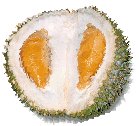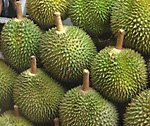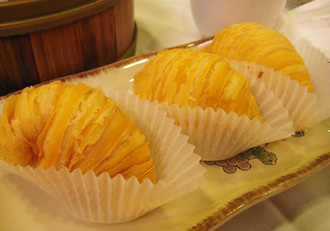Durian Fruit Nutrition facts
The durian fruit, renowned for its deliciously soft texture, is a popular tropical fruit celebrated for its unique fragrance and flavor. Widely hailed as the "King of Fruits" in numerous Southeast Asian countries, durian holds a special place in culinary traditions.
Originating from tropical regions, the durian tree belongs to the family Malvaceae, specifically in the genus Durio. This diverse botanical family encompasses various plant species, including intriguing relatives such as okra, cocoa beans, hibiscus, and cotton.
Its scientific appellation: Durio zibethinus.

|

|
| Inside view of durian cut section. Golden-yellow flesh bulbs (Durio zibethinus) | Durian fruits in the market. Note the dark green husk covered with sharp thorns. |
Durian, a fruit native to Brunei, Indonesia, and Malaysian rainforests. There are around thirty species within the Durio genus, but only nine are recognized for their edible fruit. Typically, durian trees start bearing fruit about four to five years after planting, and they can grow up to 50 meters tall, depending on the species.
This seasonal fruit is usually available from June to August, coinciding with other tropical fruits like mangosteen, jackfruit, and mango.
Characterized by its large size, distinctive odor, and formidable thorn-covered husk, the durian can measure up to 30 cm (12 in) long and 15 cm (6 in) in diameter, weighing between one to four kilograms (two to seven lb). Its shape varies from round to oblong, with a greenish-brown husk and creamy-yellow to saffron-colored flesh, depending on the species.
The durian's flesh can be consumed at different stages of ripeness and is used as a flavoring agent in various Southeast Asian culinary and sweet dishes.
Although durian seeds resemble those of jackfruit and can be safely consumed when boiled, many opt to discard them due to their bland taste, similar to jackfruit seeds.
One of the most distinctive features of the durian is its pungent odor, described as robust and penetrating, noticeable even from a distance with its husk intact. This unique scent has sparked a wide range of reactions from individuals, ranging from profound appreciation to outright disgust.
8 Amazing Health Benefits of Durian Fruit
Durian, much like other tropical fruits such as Banana, avocado, and jackfruit, boasts high energy, mineral, and vitamin content. With 147 calories per 100 grams of fresh fruit, it provides a substantial nutritional boost.
Comprised of easily digestible flesh containing simple sugars like fructose and sucrose, durian swiftly replenishes energy levels and revitalizes the body. Despite its relatively higher fat content among fruits, it is devoid of saturated fats and cholesterol.
Abundant in dietary fiber, durian serves as an excellent bulk laxative. Its fiber content safeguards the colon mucous membrane by reducing exposure time to toxins and aids in binding and eliminating cancer-causing chemicals from the gut.
The durian fruit is a notable source of antioxidant vitamin-C (approximately 33% of the Recommended Dietary Allowance). Regular consumption of vitamin C-rich foods bolsters the body's resistance against infectious agents and combats harmful free radicals.
It stands out as a superb source of B-complex vitamins, a rarity among fruits, including niacin, riboflavin, pantothenic acid (vitamin B5), pyridoxine (vitamin B-6), and thiamin (vitamin B-1). These vitamins are indispensable for bodily functions, requiring external sources for replenishment.
In addition, durian contains significant levels of essential minerals such as manganese, copper, iron, and magnesium. Manganese acts as a co-factor for the antioxidant enzyme, superoxide dismutase, while copper aids in red blood cell production, and iron is crucial for red blood cell (RBC) formation.
Fresh durian fruit emerges as a rich source of potassium, an essential electrolyte vital for controlling heart rate and blood pressure within cells and body fluids.
Furthermore, it boasts high levels of the essential amino acid tryptophan—often dubbed "nature's sleeping pill." Tryptophan metabolizes into serotonin and melatonin in humans, two neurochemicals pivotal in initiating sleep and alleviating nervous irritability.
| Principle | Nutrient Value | Percent of RDA |
|---|---|---|
| Energy | 147 Kcal | 7% |
| Carbohydrates | 27.09 g | 21% |
| Protein | 1.47 g | 2.5% |
| Total Fat | 5.33 g | 20% |
| Cholesterol | 0 mg | 0% |
| Dietary Fiber | 3.8 g | 10% |
| Vitamins | ||
| Folates | 36 mcg | 9% |
| Niacin | 1.074 mg | 7% |
| Pantothenic acid | 0.230 mg | 4.5% |
| Pyridoxine | 0.316 mg | 24% |
| Riboflavin | 0.200 mg | 15% |
| Thiamin | 0.374 mg | 31% |
| Vitamin A | 44 IU | 1.5 |
| Vitamin C | 19.7 mg | 33% |
| Electrolytes | ||
| Sodium | 2 mg | 0% |
| Potassium | 436 mg | 9.5% |
| Minerals | ||
| Calcium | 6 mg | 0.6% |
| Copper | 0.207 mg | 23% |
| Iron | 0.43 mg | 5% |
| Magnesium | 30 mg | 7.5% |
| Manganese | 0.325 mg | 14% |
| Phosphorus | 39 mg | 6% |
| Zinc | 0.28 mg | 2.5% |
| Phyto-nutrients | ||
| Carotene-α | 6 mcg | -- |
| Carotene-ß | 23 mcg | -- |
| Lutein-zeaxanthin |
Selection and storage
Durian fruit, native to Southeast Asia, finds its way to markets across East Asian countries and is also imported into the United States and Europe. Preferences vary among consumers; some favor slightly ripened, tart-flavored durians, while others savor soft and over-ripened ones. Typically, mature fruits that naturally detach from the tree are collected and sold.
When selecting durian at stores, look for specimens with firm stalks. Beyond its native regions, durian stands out as one of the most expensive items. Certain varieties, such as D24 (Sultan), enjoy significant demand and thus command higher prices. Additionally, durian can be stored in refrigerators for a few days.
Preparation and serving methods
The durian fruit's exterior is entirely encased in sharp spikes, posing a risk of cuts, thus requiring careful handling. To access its creamy yellow flesh, akin to the process for jackfruits, longitudinally cut open the fruit and then slice the flesh to extract the seeds.
Here are some serving tips:
 |
| Durian fruit pastry. Courtesy: VirtualErn |
Durian fruit serves as a flavoring base in various sweet delicacies, including traditional Malay candies, ice kachang, dodol, biscuits, and more.
Additionally, it finds usage in the creation of ice cream, milkshakes, and cappuccinos.
Yellow and red-fleshed durians are traditionally employed to produce a fermented paste condiment known as tempoyak in Malaysia and Indonesia. This fermented durian is also utilized in preparing fish tempoyak curry, made with freshwater catfish and fermented durian paste (gulai tempoyak ikan patin).
In the Sumatran islands of Indonesia, a traditional dish called Ikan brengkes features fish cooked in a durian-based sauce.
Unripe durians can be cooked as a vegetable component in a variety of dishes.
Durian seeds, resembling jackfruit seeds or yam in taste, can be consumed boiled or roasted.
≻≻-Back to Fruits from Durian Fruit. Visit here for an impressive list of all varieties of fruits with complete illustrations of their nutrition facts and health benefits.
≻≻-Back to Home page.
Further reading and Resources:
Stanford School of Medicine Cancer information Page- Nutrition to Reduce Cancer Risk.